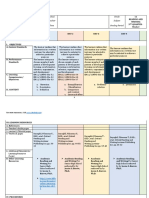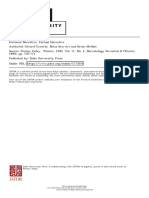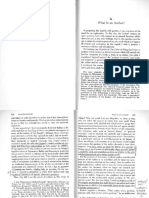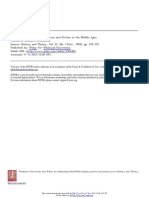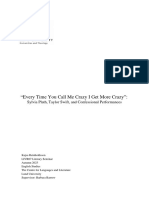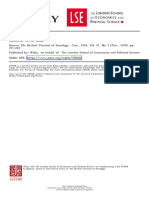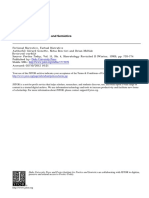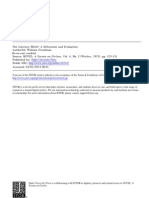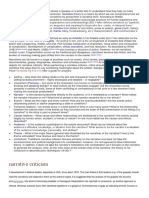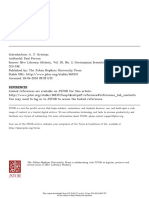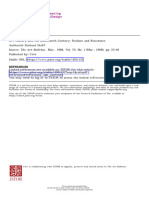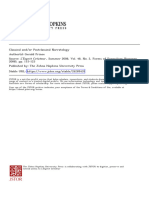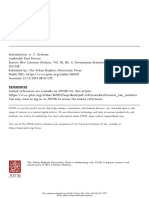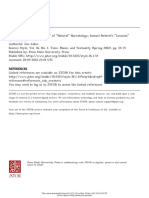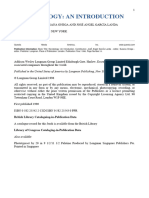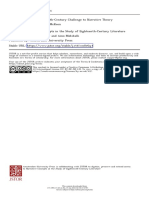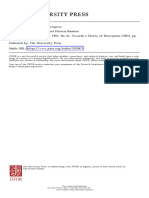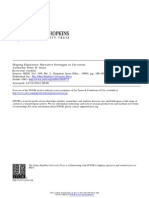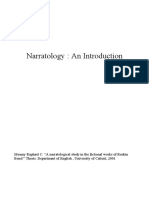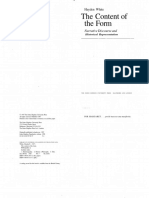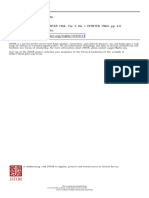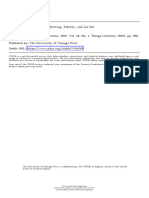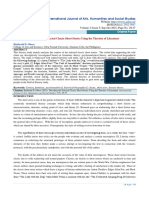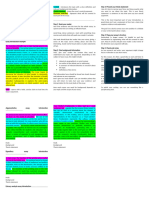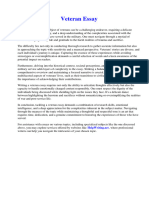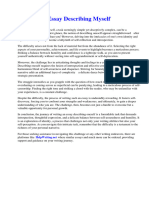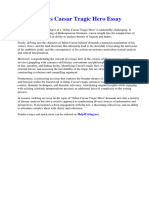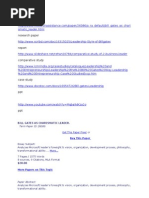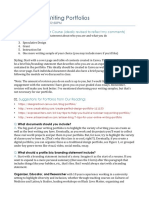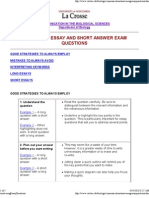This Content Downloaded From 168.176.5.118 On Wed, 14 Jul 2021 20:59:18 UTC
This Content Downloaded From 168.176.5.118 On Wed, 14 Jul 2021 20:59:18 UTC
Uploaded by
Nicolás Cortés PardoCopyright:
Available Formats
This Content Downloaded From 168.176.5.118 On Wed, 14 Jul 2021 20:59:18 UTC
This Content Downloaded From 168.176.5.118 On Wed, 14 Jul 2021 20:59:18 UTC
Uploaded by
Nicolás Cortés PardoOriginal Title
Copyright
Available Formats
Share this document
Did you find this document useful?
Is this content inappropriate?
Copyright:
Available Formats
This Content Downloaded From 168.176.5.118 On Wed, 14 Jul 2021 20:59:18 UTC
This Content Downloaded From 168.176.5.118 On Wed, 14 Jul 2021 20:59:18 UTC
Uploaded by
Nicolás Cortés PardoCopyright:
Available Formats
Review
Reviewed Work(s): On Narrative by W. J. T. Mitchell
Review by: Owen Miller
Source: Style , Spring 1983, Vol. 17, No. 2, Narratology (Spring 1983), pp. 294-297
Published by: Penn State University Press
Stable URL: http://www.jstor.com/stable/42945472
JSTOR is a not-for-profit service that helps scholars, researchers, and students discover, use, and build upon a wide
range of content in a trusted digital archive. We use information technology and tools to increase productivity and
facilitate new forms of scholarship. For more information about JSTOR, please contact support@jstor.org.
Your use of the JSTOR archive indicates your acceptance of the Terms & Conditions of Use, available at
https://about.jstor.org/terms
Penn State University Press is collaborating with JSTOR to digitize, preserve and extend access
to Style
This content downloaded from
168.176.5.118 on Wed, 14 Jul 2021 20:59:18 UTC
All use subject to https://about.jstor.org/terms
294 Book Reviews
Note
'jaap Lintvelt, Essai de typologie narrative: Le "point de vue" (Paris: Corti, 1981), p. 69,
calls Prince's "variable" monoscopique and his "multiple" polyscopique, both subdivisions of
"variable" perspective. Susan Sniader Lanser, The Narrative Act: Point of View in Prose Fiction
(Princeton: Princeton Univ. Press, 1981), p. 38, accepts Genette's terminology.
W. J. T. Mitchell, ed. On Narrative. Chicago and London: The University of
Chicago Press, 1981. x + 270 pp. $7.95.
The collection of essays that comprise this volume is an expanded
version of a special issue of Critical Inquiry, 7 (Autumn 1980), which grew out
of the symposium "Narrative: The Illusion of Sequence" held at the Univer-
sity of Chicago in October 1979. A collection of papers culled from a
symposium and published in book form tends to be uneven in quality,
fragmentary in nature, and rarely read in its entirety as a unified production.
Through W. J. T. Mitchell's experienced editing, this volume clearly escapes
all such limitations. Enlivened by a healthy critical exchange which is a regular
part of Critical Inquiry's format, these essays make fascinating reading on
some of the crucial issues of narrative theory and deserve to be approached
less as an anthology of individual pieces than as an intertextual exchange,
preserving something of the cross-fertilization of the symposium out of which
many of them grew.
As Mitchell indicates in his Foreword, the primary aim of the publica-
tion is to reflect the "debates and collaboration of literary critics, philosophers,
anthropologists, psychologists, theologians, art historians and novelists" with
the intention of carrying "the thinking about the problem of narrative well
beyond the province of the 'aesthetic' ... to explore the role of narrative in
social and psychological formations, particularly structures of value and
cognition." First and foremost, then, the collection of essays is an ambitious
attempt to consolidate (one could even say advance) the field of narratology as
a genuine interdisciplinary endeavor, one which, concurrent with similar
attempts in the field of metaphor, is central to any serious reflection on the
nature of culture and perhaps, as Hayden White has suggested, "possibly on
humanity itself." Viewed from this perspective, the seminal studies of the
volume are those of White himself (on historiography), Roy Schafer (on
psychoanalysis), Victor Turner (on anthropology), and especially Paul Ricoeur
(on philosophy).
In the opening article of the volume, Hayden White leads us through a
careful analysis of two sorts of historical representation, the Annals of Saint
Gall and a chronicle, the History of France of Riberus of Reims, challenging us
to see them less as early and primitive sorts of historical writing and more as
specific culturally-grounded modes of conceiving, ordering, and validating
This content downloaded from
168.176.5.118 on Wed, 14 Jul 2021 20:59:18 UTC
All use subject to https://about.jstor.org/terms
Book Reviews 295
events. Thus the ver
and evaluative proced
If White stresses t
distinction) Roy Sch
lysts of different pe
(or different "narrat
doing analysis and
twofold, revealing
open-ended narrati
and analysand. Schaf
psychoanalysis as "an
codes to generate psy
concepts - drives, fr
us with a new set of
and illustrating the
What emerges clear
way in which narr
historical or psycho
- in fact producing i
essay takes up much
between etnie and e
of narrative as a f
particular social gro
latter being non-cu
cerned with formal
forms of narrativi
private affairs of
account of social ac
undertakes an analy
and like Schafer, he
reintegration, recog
set of operative pr
functioning.
Like the studies which precede it, Ricoeur's essay is interdisciplinary in
nature, bringing together philosophical issues concerned with temporality
(specifically those raised by Heidegger in Being and Time) and problems of
narrative (especially those of plot). Here I believe we encounter the seminal
essay of the collection, for Ricoeur is enlightening not only in his dialectical
mode of relating temporality to narrativity but also in the manner in which he
challenges us to re-examine in a new light certain basic assumptions, with
respect to narrative, of the anti-narrativist epistemologists and structuralist
literary critics. His remarks function in so many ways as a sort of metacom-
mentary on several key issues raised by the other contributors and at the same
This content downloaded from
168.176.5.118 on Wed, 14 Jul 2021 20:59:18 UTC
All use subject to https://about.jstor.org/terms
296 Book Reviews
time serve as a br
between literary
visual art and Seym
is more properly ro
diverse contributi
Guin.
Goodman's analysis of how temporal sequence is spatialized in a
number of "narrative paintings" drawn from both occidental and oriental
traditions leads him to question some of the basic presuppositions about the
constituent elements of narrative and specifically about sequentiality. Of
special interest is his contention that aesthetic criteria may often dictate
temporal ordering in the narrative sequence. A similar concern motivates
Seymour Chatman's close analysis of a Maupassant story, "Une partie de
campagne" and its cinematic rendering by Jean Renoir in a film of the same
name. Chatman focuses specifically on the reductive aspect of many studies of
narratology where the story-structure or diegetic level is examined and the
medium of presentation bracketed. The demonstration here is designed to
illustrate the specificity of narrative representation in film.
Undoubtedly the strength of this volume lies in its attempt to wean the
discipline of narratology away from the exclusive preserve of literary criticism
and to establish for it new coordinates by bringing them to bear on what we
think of as non-literary fields of enquiry. Paradoxically, however, such a
strategy is precisely what brings pertinence to those essays in the volume
which appear, no matter how idiosyncratically, to address problems of literary
narrative. What links such overtly diverse studies as those of Derrida,
Kermode, and Le Guin is their concern for (if we may stretch a little
Jakobson's term) the "literariness" of literature. As the narrative loses its
automatic association with the institution of literature, we are challenged to
take up anew the problem of literary production in this new context.
Kermode's notion of "secrets" suggests tendencies which work against
narrative connexity and causality, evoking agents which resist easily achieved
processes of cognitive assimilation or accommodation and are deployed by
writers such as Conrad in a novel like Under Western Eyes. In similar fashion,
through a clever semantic play on notions of conformity and deviance,
Derrida weaves a discursive pattern which embraces differing conceptual
frameworks of legality, insanity, and literature, specifically in relationship to
Maurice Blanchoťs La Folie du jour. His analysis of the concept of genre
represents a masterly attempt to re-ground literariness in anti-narrative
coordinates whose center is the counter-discipline of textuality. Finally,
Ursula Le Guin eschews almost totally an expository stance, preferring to
communicate her thoughts through a parodically inspired piece, generically
undefinable, which carries us back to that social experience where our early
magical encounter with narrative is more often than not around a campfire
This content downloaded from
168.176.5.118 on Wed, 14 Jul 2021 20:59:18 UTC
All use subject to https://about.jstor.org/terms
Book Reviews 297
but leads us neverth
"storytelling" is a fo
values.
It is difficult to convey in so short a summary the richness of perspec-
tives provide by this collection of essays on narrative. Each contributor (not to
mention the provocative and often insightful critiques offered in the "After-
thoughts" by Paul Hernadi, Robert Scholes, Louis Mink, Marilyn Waldman,
and especially Barbara Herrnstein Smith) succeeds not only in crystallizing a
number of central issues of narratology but also, through a wealth of
bibliographical references mentioned in the footnotes or in the body of the
discussion, in encouraging the reader to pursue by further reading the trails
left. Like the subject which furnished its topic, On Narrative succeeds in
establishing itself (to quote editor Mitchell's own words) "as a positive source
of insight for all branches of human and natural science."
Owen Miller
Michael Riffaterre. La Production du texte. Paris: Seuil, 1979. 287 pp. $14.00.
La Production du texte presents a sampling of Michael Riffaterre's work
that essentially spans the period from the end of the 1960s to the middle of the
1970s. Unfortunately, the French editor gives no indication of the origins of
the various essays that are reprinted here, and one is obliged to reconstruct the
historical sequence of the essays oneself. Short bibliographical footnotes
would have been very helpful indeed. The book is divided into two parts: the
first deals with theoretical questions on a more general level and the second
takes up questions raised by Riffaterre's readings of specific literary texts
ranging from Du Bellay to Francis Ponge and Julien Gracq.
The characteristics of the analytical method developed by Riffaterre over
the last few years may best be adumbrated by noting the manner in which that
method differs from traditional rhetorical analysis, literary criticism as it is
normally understood, and linguistics. For Riffaterre, rhetoric is insufficient for
the analysis of literary texts because it moves in the direction of generalization
and prescriptive codification, thereby neglecting the specific and unique
characteristics of each literary text. Literary criticism is the step in the study of
literature which comes after textual analysis and is concerned with value
judgments. Analysis, or what Riffaterre calls explication, necessarily precedes
criticism per se and yields results that are then appropriated by criticism.
Finally, because explication studies the behavior of words in the context of
literary works, it is closely related to linguistics. However, as in the case of
rhetoric, linguistics tends toward universalization. Linguistics as poetics
attempts to construct a model or grammar of poetic language. In so doing, it
This content downloaded from
168.176.5.118 on Wed, 14 Jul 2021 20:59:18 UTC
All use subject to https://about.jstor.org/terms
You might also like
- Week 2 DLLDocument7 pagesWeek 2 DLLChernie Deroma Obsenares100% (2)
- Lodge - Analysis and Interpretation of The Realist TextDocument19 pagesLodge - Analysis and Interpretation of The Realist TextHumano Ser0% (1)
- Tzvetan Todorov and Richard M. Berrong - The Origin of Genres - 1976 PDFDocument13 pagesTzvetan Todorov and Richard M. Berrong - The Origin of Genres - 1976 PDFNasirNo ratings yet
- Genette - Fictional Narrative, Factual NarrativeDocument21 pagesGenette - Fictional Narrative, Factual NarrativeSilviaNo ratings yet
- Michel Foucault - What Is An Author, U: Language, Counter-Memory, PracticeDocument14 pagesMichel Foucault - What Is An Author, U: Language, Counter-Memory, PracticeJosip CmrečnjakNo ratings yet
- Prof. Dr. E. (Esther) Peeren Objects of Cultural Analysis 13 October 2018Document3 pagesProf. Dr. E. (Esther) Peeren Objects of Cultural Analysis 13 October 2018Anonymous Izl4KkS16cNo ratings yet
- Todorov-StructuralAnalysisNarrative-1969Document8 pagesTodorov-StructuralAnalysisNarrative-1969chatterjeearkadip2No ratings yet
- FLEISCHMANN, Suzanne, On The Representation of History and Fiction in The Middle AgesDocument34 pagesFLEISCHMANN, Suzanne, On The Representation of History and Fiction in The Middle AgesAndrejka NováNo ratings yet
- This Content Downloaded From 187.67.107.143 On Thu, 11 Aug 2022 01:37:32 UTCDocument29 pagesThis Content Downloaded From 187.67.107.143 On Thu, 11 Aug 2022 01:37:32 UTCMaria Ester MartinsNo ratings yet
- KajsaReinholdsson MAThesis LCM LIVR07Document93 pagesKajsaReinholdsson MAThesis LCM LIVR07Hana TawilNo ratings yet
- Sociology LiteratureDocument15 pagesSociology Literatureadamfv1991No ratings yet
- Fictional Narrative, Factual Narrative - GenetteDocument21 pagesFictional Narrative, Factual Narrative - GenetteElton Guimarães100% (1)
- 书评Document3 pages书评光木No ratings yet
- The Literary Motif - William FreedmanDocument10 pagesThe Literary Motif - William FreedmanDiego Pérez Hernández100% (1)
- 98-134. 3. Project For A Discursive CriticismDocument38 pages98-134. 3. Project For A Discursive CriticismBaha ZaferNo ratings yet
- John 2Document11 pagesJohn 2Ma. Rizza DanoNo ratings yet
- The Johns Hopkins University Press New Literary HistoryDocument17 pagesThe Johns Hopkins University Press New Literary HistoryfrankNo ratings yet
- Art History and The Nineteenth Century-Realism and ResistanceDocument25 pagesArt History and The Nineteenth Century-Realism and ResistancennazolgacNo ratings yet
- Friedrich Schlegel and The Myth of IronyDocument27 pagesFriedrich Schlegel and The Myth of IronyDustin CauchiNo ratings yet
- Classical and or Postclassical NarratologyDocument10 pagesClassical and or Postclassical NarratologyccarringNo ratings yet
- 3 Introduction A. J. GreimasDocument17 pages3 Introduction A. J. GreimaschristinemzNo ratings yet
- Lives in Fiction: Auto/biography As Theoretical Narrative: Asia-Pacific Social Science Review January 2014Document19 pagesLives in Fiction: Auto/biography As Theoretical Narrative: Asia-Pacific Social Science Review January 2014PaolaNo ratings yet
- ABSTRACT Article On AutobiographyDocument48 pagesABSTRACT Article On AutobiographyRups GiriNo ratings yet
- Écritures de Soi-Michel TournierDocument8 pagesÉcritures de Soi-Michel TournierChiara CanessaNo ratings yet
- Scries Editor: I) Avitl Ierman, North Carolina State UniversityDocument429 pagesScries Editor: I) Avitl Ierman, North Carolina State UniversityTeodoragrapaNo ratings yet
- NARRATOLOGYDocument16 pagesNARRATOLOGYiellariembiNo ratings yet
- Alber - Moreness and LessnessDocument23 pagesAlber - Moreness and LessnessMacarenaNo ratings yet
- Narratology - An IntroductionDocument204 pagesNarratology - An Introductionghonwa hammodNo ratings yet
- The Eighteenth-Century Challenge To Narrative TheoryDocument41 pagesThe Eighteenth-Century Challenge To Narrative Theoryjuan acuñaNo ratings yet
- BLOOMFIELD, M. W. Allegory As InterpretationDocument18 pagesBLOOMFIELD, M. W. Allegory As InterpretationRebecca HernandezNo ratings yet
- The Making of Fictional Worlds - OCRDocument30 pagesThe Making of Fictional Worlds - OCRAndrés MoraNo ratings yet
- Architecture and Modern Literature by David Spurr (Review) : January 2014Document6 pagesArchitecture and Modern Literature by David Spurr (Review) : January 2014Erik MrakovcicNo ratings yet
- The Novel As An AbsenceDocument17 pagesThe Novel As An AbsenceZedarNo ratings yet
- Bloomfield InterpDocument18 pagesBloomfield Interpread321No ratings yet
- 5Document3 pages5Shagun ChoudharyNo ratings yet
- Clare Hanson ArtículoDocument23 pagesClare Hanson ArtículoRevistanudosNo ratings yet
- Hamon - 1981 - Rhetorical Status of The DescriptiveDocument27 pagesHamon - 1981 - Rhetorical Status of The DescriptiveMartínNo ratings yet
- Still Life: A User's Manual: Narrative May 2002Document17 pagesStill Life: A User's Manual: Narrative May 2002Daisy BogdaniNo ratings yet
- 978 1 5275 7716 9 SampleDocument30 pages978 1 5275 7716 9 SampleBhatt PawanNo ratings yet
- Narrative and Philosophy: A Formal-Historical ApproachDocument18 pagesNarrative and Philosophy: A Formal-Historical ApproachAnna ZambrowiczNo ratings yet
- Lesic Memory Narratology Authenticity-Penultimate VersionDocument16 pagesLesic Memory Narratology Authenticity-Penultimate VersionAndrea LešićNo ratings yet
- Dunn, Shaping Experience, Narrative Strategies in CervantesDocument19 pagesDunn, Shaping Experience, Narrative Strategies in CervantescasucuNo ratings yet
- Curso La Verdad de La NarrativaDocument8 pagesCurso La Verdad de La NarrativamariopadillaNo ratings yet
- Semiology and RhetoricDocument8 pagesSemiology and RhetoricJhonNo ratings yet
- Barthes Intro To Structural AnalysisDocument37 pagesBarthes Intro To Structural AnalysisAdriana EspinozaNo ratings yet
- Bakhtin, Temporality, and Modern NarrativeDocument27 pagesBakhtin, Temporality, and Modern NarrativeekinozkNo ratings yet
- On Narrativity Stuart Whitling PHD 2Document15 pagesOn Narrativity Stuart Whitling PHD 2Слађана МитровићNo ratings yet
- 6 ConclusionDocument10 pages6 ConclusionPhilip JosephNo ratings yet
- (New Literary Theory) Hywel Dix - Autofiction and Cultural Memory-Routledge (2022)Document125 pages(New Literary Theory) Hywel Dix - Autofiction and Cultural Memory-Routledge (2022)eppccdg100% (4)
- Literary CriticismDocument22 pagesLiterary CriticismSofia HoranNo ratings yet
- Lyric History and GenreDocument23 pagesLyric History and GenrePiyush K VermaNo ratings yet
- Narratology: An IntroductionDocument30 pagesNarratology: An IntroductionhafizhNo ratings yet
- Felski - Context StinksDocument20 pagesFelski - Context Stinksleretsantu100% (1)
- (Rethinking Theory) Bart Keunen - Time and Imagination - Chronotopes in Western Narrative Culture-Northwestern University Press (2011)Document169 pages(Rethinking Theory) Bart Keunen - Time and Imagination - Chronotopes in Western Narrative Culture-Northwestern University Press (2011)María Paula Ramírez100% (1)
- Hayden White Narrative DiscourseDocument66 pagesHayden White Narrative DiscourseAmalia IoneLaNo ratings yet
- LODGE, D. (1966) - The Rhetoric of Wayne BoothDocument4 pagesLODGE, D. (1966) - The Rhetoric of Wayne BoothMariano DagattiNo ratings yet
- Chow FatefulAttachmentsCollecting 2001Document20 pagesChow FatefulAttachmentsCollecting 2001jennifer shearNo ratings yet
- Ijahss0305005 29 37Document9 pagesIjahss0305005 29 37International Journal of Arts, Humanities and Social Studies (IJAHSS)No ratings yet
- 01 - Roland Barthes - From Work To TextDocument6 pages01 - Roland Barthes - From Work To TextWENXIN LIANGNo ratings yet
- Vital Signs: Medical Realism in Nineteenth-Century FictionFrom EverandVital Signs: Medical Realism in Nineteenth-Century FictionNo ratings yet
- How To Write An Essay Introduction 4 Steps & ExamplesDocument2 pagesHow To Write An Essay Introduction 4 Steps & ExamplesAngelo QuintoNo ratings yet
- Dissertation Prospectus SlidesDocument5 pagesDissertation Prospectus SlidesProfessionalPaperWritingServiceSingapore100% (1)
- Teacher Support Material (TSM) 2020Document32 pagesTeacher Support Material (TSM) 2020Sahire ArslanNo ratings yet
- GreatWriting 5E - Level 2 - CEFR CorrelationsDocument63 pagesGreatWriting 5E - Level 2 - CEFR CorrelationsyylamNo ratings yet
- First Writing Part 1 and 2Document29 pagesFirst Writing Part 1 and 2Bruno Henrique Peres100% (1)
- Thesis Information TechnologyDocument7 pagesThesis Information Technologymelissabuckleyomaha100% (2)
- Computer Science Term Paper IdeasDocument6 pagesComputer Science Term Paper Ideasafmzksqjomfyej100% (1)
- Example of Topic Sentence and Thesis StatementDocument4 pagesExample of Topic Sentence and Thesis Statementgjgm36vk100% (2)
- Daily Lesson LogDocument12 pagesDaily Lesson LogNiña Romina G. NavaltaNo ratings yet
- Writing A Narrative EssayDocument6 pagesWriting A Narrative EssayBob Bol0% (1)
- Thesis Statement For Position PaperDocument8 pagesThesis Statement For Position Paperanitastrongannarbor100% (2)
- 4309 Psychology 101 Unit Outline 2010 f2f FINALDocument17 pages4309 Psychology 101 Unit Outline 2010 f2f FINALElliott PorterNo ratings yet
- Department of Arts and Sciences Education GE8 - Course SyllabusDocument7 pagesDepartment of Arts and Sciences Education GE8 - Course SyllabusYheng Sisbreño LancianNo ratings yet
- Learning Activities Packet - Puritan/ColonialDocument6 pagesLearning Activities Packet - Puritan/ColonialMorganReidNo ratings yet
- Veteran EssayDocument3 pagesVeteran Essayrlxaqgnbf100% (2)
- Example of Chapter One DissertationDocument6 pagesExample of Chapter One DissertationBuyingPapersOnlineCollegeCanada100% (1)
- Assignment 1 EappDocument10 pagesAssignment 1 EappCarrie Lhee BoadoNo ratings yet
- Essay Describing MyselfDocument3 pagesEssay Describing Myselfd3h7qfpr100% (2)
- Julius Caesar Tragic Hero EssayDocument7 pagesJulius Caesar Tragic Hero Essayxtnzpacaf100% (2)
- Research Paper: Bill Gates As Charismatic LeaderDocument4 pagesResearch Paper: Bill Gates As Charismatic Leaderkhushiyadav630% (1)
- Learning: Are You An Early Bird or A Night Owl?Document16 pagesLearning: Are You An Early Bird or A Night Owl?Roshdi AlfaouriNo ratings yet
- Sample Thesis About Fire PreventionDocument6 pagesSample Thesis About Fire Preventionheatherharveyanchorage100% (2)
- The Role of Youth in SocietyDocument12 pagesThe Role of Youth in SocietyJoshua CadioganNo ratings yet
- Chapter 13Document7 pagesChapter 13Mirgank TirkhaNo ratings yet
- Professional Writing PortfoliosDocument3 pagesProfessional Writing PortfoliosWill KurlinkusNo ratings yet
- Cracking Ap World History PT 5 AnswersDocument15 pagesCracking Ap World History PT 5 Answersapi-406979573No ratings yet
- Victorian Literature and FinanceDocument216 pagesVictorian Literature and FinancezuppadipomodoroNo ratings yet
- Answering Essay QuestionsDocument5 pagesAnswering Essay QuestionsLee Sai KeatNo ratings yet
- Irregular Warfare 10-11Document16 pagesIrregular Warfare 10-11materialguy1No ratings yet
